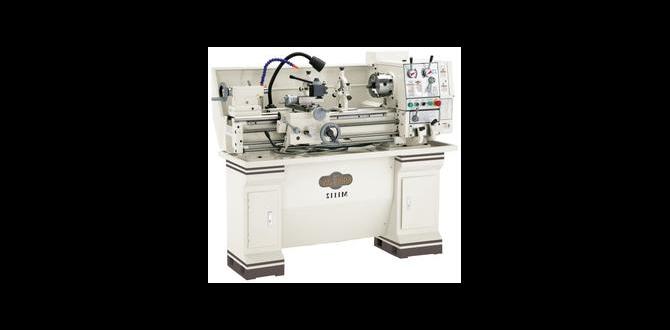Carbide End Mill 1/8 Inch: Solved Peek Deflection! Get cleaner cuts on your next project with this essential guide.
Dealing with deflection when machining plastics like PEEK can be frustrating, especially with smaller tools. That delicate 1/8 inch carbide end mill seems to have a mind of its own, bending just enough to ruin a perfect cut. Don’t worry, it’s a common challenge many machinists face. We’ll walk through exactly why it happens and, more importantly, share some clever tricks to keep that tiny mill cutting true. Get ready to achieve those smooth, accurate PEEK parts you’ve been aiming for!
Understanding PEEK and Why It’s Tricky
Polyetheretherketone, or PEEK, is a fantastic material. It’s strong, heat-resistant, and has excellent chemical resistance. This makes it a top choice for demanding applications in aerospace, medical devices, and automotive industries. However, its machining characteristics can be a bit… unique, especially for beginners. Unlike metal, PEEK is less rigid and can be more prone to gummy behavior or melting if not handled correctly. These properties, combined with the small size of a 1/8 inch end mill, create a perfect storm for deflection.
What Exactly is Mill Deflection?
Mill deflection, in simple terms, is when your cutting tool bends or moves away from its intended path during the machining process. Think of it like a flexible ruler being pushed sideways – it bends. In milling, this bending can happen due to the forces of the cut, the material you’re working with, and the tool itself. When a 1/8 inch carbide end mill deflects, it means the tip isn’t following the programmed path precisely. This leads to:
Oversized or undersized features: Your part won’t be as accurate as intended.
Rough surface finish: The cut won’t be clean or smooth.
Tool breakage: Excessive deflection can put too much stress on the tiny tool, causing it to snap.
Why Small End Mills and PEEK Are a Deflection Duo
The 1/8 inch carbide end mill is a fantastic tool for intricate details and small parts. However, its very nature also makes it susceptible to deflection. Here’s why:
Length-to-Diameter Ratio: Smaller diameter tools, especially when held a bit too far out of the collet or tool holder, have a higher length-to-diameter ratio. This means they have more “reach” and are more flexible, making them bend easier.
Material Properties of PEEK: PEEK is a tough plastic. It requires a decent amount of force to cut. When a small, relatively flexible 1/8 inch end mill encounters this resistance, it’s bound to bend.
Heat Buildup: PEEK can soften and become “gummy” with excessive heat. This gummy material can grab the cutting edges, significantly increasing cutting forces and thus, deflection.
The Genius Peek Deflection Solution: A Multi-Pronged Approach
Solving deflection with a 1/8 inch carbide end mill in PEEK isn’t about one magic bullet. It’s about a smart combination of tool selection, machine setup, and cutting strategy. Let’s break it down.
1. Choosing the Right 1/8 Inch Carbide End Mill
Not all 1/8 inch carbide end mills are created equal, especially when you’re targeting PEEK. Look for these features:
Number of Flutes: For plastics like PEEK, fewer flutes generally perform better.
2-Flute End Mills: These are often the go-to choice for plastics. They offer good chip clearance, which is crucial for preventing buildup and heat. The extra space between the flutes allows chips to escape easily.
3-Flute End Mills: These can sometimes work, but they tend to generate more heat due to cutting more material per revolution. They might be better for certain metals.
4-Flute End Mills: Generally not recommended for PEEK as they offer less chip clearance and pack chips easily, leading to heat and poor surface finish.
Coating: A coating like TiCN (Titanium Carbonitride) or ZrN (Zirconium Nitride) can help reduce friction and heat buildup. This can be a subtle but significant advantage. Some specialized coatings are designed specifically for plastics.
Corner Radius: Sometimes, a 1/8 inch end mill with a small corner radius (e.g., 0.010″ or 0.020″) can help strengthen the tool tip and provide a smoother transition into and out of the cut, reducing chatter and deflection. A square end mill can be more prone to chipping and deflection at the corner.
End Mill Geometry: Look for end mills designed for plastics or general-purpose machining. Spiral flute designs are standard and effective. Some might have a hook or rake angle optimized for softer materials.
Recommended Carbide End Mill Specifications for PEEK
| Feature | Recommendation for PEEK | Why |
| :————– | :———————- | :—————————————————— |
| Diameter | 1/8 inch | As per the topic, for detail work. |
| Shank Size | 1/8 inch (standard) | Ensures a secure grip in collets and tool holders. |
| Length | Standard length | Avoids excessive tool overhang, minimizing deflection. |
| Flutes | 2 | Best chip clearance for plastics, reduces heat buildup. |
| Material | Solid Carbide | Provides rigidity and heat resistance. |
| Coating | TiCN, ZrN, or plastic-specific | Reduces friction, heat, and wear. |
| Corner | Square or small radius | Square for sharp corners, radius for added strength. |
2. Machine Setup: The Foundation of Accuracy
Even the best end mill will struggle if your machine setup isn’t dialed in. This is where many beginner frustrations start.
Tool Holder and Collet:
Proper Fit: Ensure your 1/8 inch collet is the correct size and in good condition. A worn collet won’t grip the tool consistently.
Cleanliness: Absolutely critical! Any debris, dust, or oil in the collet or collet nut can cause the tool to run out or be gripped unevenly. Clean them thoroughly before each use.
Tool Projection/Stick-out: This is HUGE. The less your end mill sticks out beyond the collet, the less it will deflect. Aim to have the cutting portion of the end mill as close to the collet as possible while still allowing it to reach the bottom of your cut. For a 1/8 inch tool, a projection of 1/2 inch to 1 inch is often a good starting point, depending on the cutter’s length.
Tool Balanacing: For high-speed spindle machines, using a balanced tool holder can reduce vibration, which indirectly helps prevent deflection.
Spindle Rigidity: A stiff spindle is essential. If your machine’s spindle has play, even a little bit will amplify any forces applied to the tool. Ensure your spindle bearings are in good condition.
Workholding:
Secure Clamping: The PEEK workpiece must be held very securely. Any movement of the workpiece during the cut will transmit forces that exacerbate tool deflection. Use vises, clamps, or fixtures that provide strong, stable holding.
Support: For larger or thinner parts, consider using support pins or a backing plate to prevent the material from deflecting away from the tool.
3. Cutting Strategies to Fight Deflection
How you tell your machine to cut is just as important as the tools and setup you use. Smart cutting parameters and strategies can dramatically reduce deflection.
a) Optimize Your Feeds and Speeds
This is the most critical area. Getting feeds and speeds wrong is the fastest way to invite deflection and tool failure.
Spindle Speed (RPM): Plastics like PEEK generally benefit from higher spindle speeds compared to many metals. This allows the tool to cut chips cleanly and quickly, reducing heat buildup. A common starting range for a 1/8 inch end mill might be 10,000 – 20,000 RPM, but this can vary greatly depending on your specific PEEK grade and machine.
Feed Rate (IPM or mm/min): This is where balance is key.
Too Slow: A slow feed rate means the tool spends too much time in contact with the material at any given point. This generates heat, creates rubbing instead of cutting, and can lead to gummy chips, all of which increase deflection.
Too Fast: A feed rate that is too high for the RPM and number of flutes will cause the tool to “plow” through the material, leading to excessive cutting forces, chatter, and deflection. It can also snap the tool.
Chip Load Concept: The “chip load” is the thickness of the material being removed by each cutting edge of the end mill per revolution. For PEEK and a 2-flute 1/8 inch end mill, you’re generally looking for a chip load that’s not too thin (causes rubbing) and not too thick (causes excessive force). A good starting point might be in the range of 0.001″ to 0.003″ per tooth.
Calculation: Feed Rate = Chip Load per Tooth × Number of Flutes × Spindle Speed (RPM)
Example: If you want a chip load of 0.002″ at 15,000 RPM with a 2-flute end mill: 0.002″ × 2 × 15,000 RPM = 60 IPM.
Finding the perfect balance often involves a bit of experimentation. Start conservatively and increase the feed rate until you hear a clean cutting sound without chatter.
b) Depth of Cut (DOC) and Stepover
These parameters control how much material the tool engages at once.
depth of cut (DOC): Always use a shallow depth of cut when working with PEEK and small end mills. Trying to hog out material in a single pass will almost guarantee deflection.
Rule of Thumb: For a 1/8 inch end mill, a DOC of 0.050″ to 0.100″ is often a good starting point. You might even go shallower. The goal is to let the tool do its work without being overwhelmed.
Multiple Passes: It’s far better to take multiple shallow passes than one deep pass. This distributes the cutting load and minimizes deflection.
Stepover: This is the amount the tool moves sideways (X or Y direction) for each new depth cut.
For Slotting: When cutting a full slot, the stepover is essentially the diameter of the tool (1/8 inch).
For Profiling/Contouring: When cutting around the outside or inside of a shape, you’ll use a smaller stepover. A stepover of 20-50% of the tool diameter is common.
Too small a stepover with too large a DOC can lead to the tool rubbing, causing heat and deflection.
Too large a stepover means more passes, which extends machining time but can reduce forces per pass.
c) Cutting Motion: Climb Milling vs. Conventional Milling
This is a crucial detail for reducing deflection, especially with plastics.
Conventional Milling: The cutter rotates against the direction of feed. This tends to lift the material, creating more friction and heat. It’s generally less stable and can push the tool deeper into the material, increasing deflection.
Climb Milling: The cutter rotates in the same direction as the feed. The cutting edge engages the material at the top of the cut and moves downwards. This “pulls” the tool down into the material, generally resulting in less upward force on the tool, a cleaner chip, and less deflection. Climb milling is highly recommended for PEEK when possible.
Consideration: Climb milling requires machines with minimal backlash in the feed drives. If your machine has a lot of play, conventional milling might be more predictable, though still more prone to deflection.
d) Using Air Cuts (Micros) for Finishing
For critical surfaces where geometry is vital, a finishing pass with a very shallow depth of cut (like 0.001″ to 0.003″) at the programmed final dimension can help clean up any slight inaccuracies caused by earlier passes. This is sometimes called a “clean-up pass” or “air cut” if the depth is extremely small and programmed to be practically zero.
e) Coolant/Lubrication
While flood coolant isn’t typically used for PEEK and can contaminate some applications, a light mist of a suitable plastic-cutting lubricant or even compressed air can help evacuate chips and reduce heat.
Compressed Air: A steady blast of compressed air directed at the cutting zone is excellent for PEEK. It helps clear chips, prevents them from re-cutting, and cools the tool and material.
Plastic-Specific Lubricants: Some specialized lubricants are available that reduce friction without causing issues with the plastic. Always test these in an inconspicuous area first.
4. Advanced Techniques and Considerations
Once you’ve mastered the basics, you can explore these further:
Using a 1/8 inch 1/4 Shank Standard Length End Mill for PEEK
The topic specifically mentions using a “1/8 inch 1/4 shank standard length” end mill. To clarify, this means the cutting diameter is 1/8 inch, and the shank (the part that goes into the tool holder) is 1/4 inch.
Benefit of Larger Shank: A 1/4 inch shank on a 1/8 inch diameter cutter offers a significant advantage! It means a much shorter flute length relative to the shank diameter, or a much thicker shank for a given flute length. This dramatically increases the rigidity of the tool by reducing the unsupported length of the cutting edge projecting from the holder. This is a key strategy for fighting deflection.
Standard Length: “Standard length” generally refers to the commonly available lengths for a given cutter shank and diameter. When paired with a 1/8 inch cutting diameter on a 1/4 inch shank, it usually implies designs that prioritize rigidity over extreme reach.
High-Feed Milling Strategies
Though more advanced, for some applications, high-feed milling inserts or cutters can be used. However, for a 1/8 inch end mill, this is less applicable. The principles of using small stepovers (often less than 10% of the tool diameter) and high feed rates relative to RPM are key. For a 1/8 inch tool, this often translates to the optimized chip load discussions we’ve already covered.
Material Considerations
PEEK Grades: Different grades of PEEK have slightly different mechanical properties. Some reinforced grades (like glass-filled PEEK) can be more abrasive and brittle, while unfilled PEEK is softer. Understand the specific PEEK you are machining.
Machining Charts: Always refer to recommended machining charts from your PEEK supplier or the end mill manufacturer. These provide excellent starting points for feeds and speeds. For instance, companies like MachiningDoctor.com offer valuable resources for machining different materials, including helpful starting parameters.
Avoiding Common Pitfalls
Ignoring “Stick-out”: This is the single biggest mistake beginners make with small tools. Keep it as short as possible.
Using the Wrong Tool: A sharp, high-quality end mill designed for plastics makes a huge difference.
Too Deep a Cut: Trying to remove too much material at once.
Insufficient Chip Clearance: Leading to chip recutting and heat.
Workpiece Movement: Not clamping the part securely.
Over-Reliance on Coolant: For many plastics, air blast is better than liquid coolant.
Here’s a quick example of how using a 1/8″ end mill on a 1/4″ shank helps:
Imagine you need to cut to a depth of 0.5 inches.
Scenario A: 1/8″ Shank, 1/8″ Diameter End Mill
If the usable flute length is 0.5 inches or more, you’ll have 0.5 inches of unsupported cutting edge. This can be quite flexible.
Scenario B: 1/4″ Shank, 1/8″ Diameter End Mill
Even if the flute length needed is 0.5 inches, the 1/4″ shank provides much more rigidity. The tool holder grips a larger diameter, significantly reducing the tendency to deflect. If the usable flute length is shorter than 0.5 inches, you’ll need multiple passes, but the tool itself will be inherently stiffer.
Frequently Asked Questions (FAQ)
Q1: What’s the best type of 1/8 inch end mill for cutting PEEK?
A1: For PEEK, a 2-flute solid carbide end mill is generally best. Look for one with a coating like TiCN or ZrN to help reduce heat and friction. Avoid end mills with many flutes, as they can struggle with chip evacuation.
Q2: How does the 1/4 inch shank on a 1/8 inch end mill help with deflection?
A2: A larger shank (like 1/4″) provides significantly more rigidity to the tool. It reduces the unsupported length of the cutting edge, making the tool much less prone to bending under cutting forces. This is a fantastic advantage for cutting materials like PEEK.
Q3: What are typical feeds and speeds for a 1/8 inch end mill in PEEK?
A3: Start with higher RPMs (10,00




